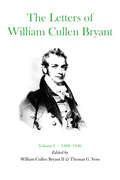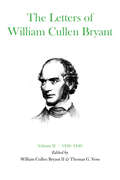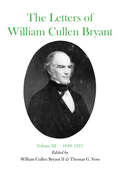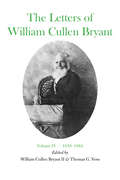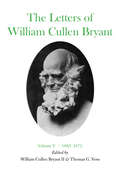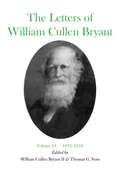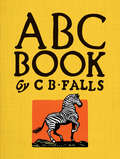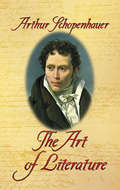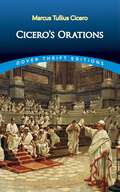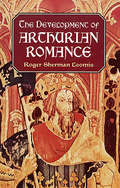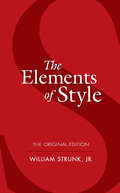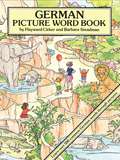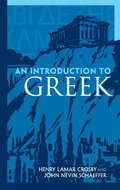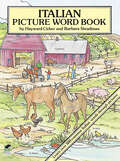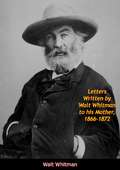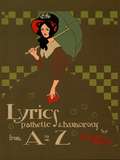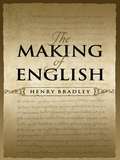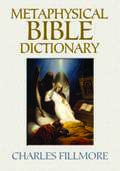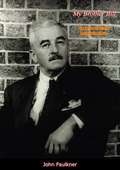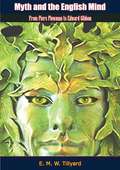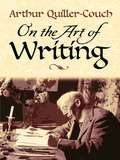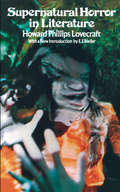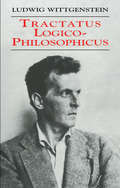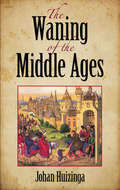- Table View
- List View
The Letters of William Cullen Bryant: Volume I, 1809–1836
by William Cullen BryantThis is the only collection ever made of Bryant's letters, two-thirds of which have never before been printed. Their publication was foreseen by the late Allan Nevin as "one of the most important and stimulating enterprises contributory to the enrichment of the nation's cultural and political life that is now within range of individual and group effort.William Cullen Bryant (1794–1878) was America's earliest national poet. His immediate followers—Longfellow, Poe, and Whitman—unquestionably began their distinguished careers in imitation of his verses. But Bryant was even more influential in his long career as a political journalist, and in his encouragement of American art, from his lectures at the National Academy of Design in 1828 to his evocation of the Metropolitan Museum of Art in 1870. Between the appearance of his first major poem, "Thanatopsis," in 1817, and his death sixty-one years later at the age of eight-three, Bryant knew and corresponded with an extraordinary number of eminent men and women. More than 2,100 of his know letters have already been recovered for the present edition.When William Cullen Bryant signed the first of 314 letters in the present volume, in 1809, he was a frail and shy farm boy of fourteen who had nonetheless already won some fame as the satirist of Thomas Jefferson. When he wrote the last, in 1836, he had become the chief poet of his country, the editor of its principal liberal newspaper, and the friend and collaborator of its leading artists and writers. His collected poems, previously published at New York, Boston, and London, were going into their third edition. His incisive editorials in the New York Evening Post were affecting the decisions of Andrew Jackson's administration. His poetic themes were beginning to find expression in the landscape paintings of Robert Weir, Asher Durand, and Thomas Cole.The early letters gathered here in chronological order give a unique picture of Cullen Bryant's youth and young manhood: his discipline in the classics preparatory to an all-too-brief college tenure; his legal study and subsequent law practice; the experiments with romantic versification which culminated in his poetic masterpieces, and those with the opposite sex which led to his courtship and marriage; his eager interest in the politics of the Madison and Monroe Presidencies, and his subsequent activities as a local politician and polemicist in western Massachusetts; his apprenticeship as magazine editor and literary critic in New York City, from which his later eminence as journalist was the natural evolution; the lectures on poetry and mythology which foreshadowed a long career as occasional orator; the collaboration in writing The Talisman, The American Landscape, and Tales of Glauber-Spa, and in forming the National Academy of Design, and the Sketch Club, which brought him intimacy with writers, artists, and publishers; his first trip to the Aemrican West, and his first long visit to Europe, during which he began the practice of writing letters to his newspaper which, throughout nearly half a century, proved him a perceptive interpreter of the distant scene to his contemporaries.Here, in essence, is the first volume of the autobiography of one whom Abraham Lincoln remarked after his first visit to New York City in 1860, "It was worth the journey to the East merely to see such a man." And John Bigelow, who of Bryant's many eulogists knew him best, said in 1878 of his longtime friend and business partner, "There was no eminent American upon whom the judgment of his countrymen would be more immediate and unanimous. The broad simple outline of his character and career had become universally familiar, like a mountain or a sea."
The Letters of William Cullen Bryant: Volume II, 1836–1849
by William Cullen BryantThe second volume of William Cullen Bryant's letters opens in 1836 as he has just returned to New York from an extended visit to Europe to resume charge of the New York Evening Post, brought near to failure during his absence by his partner William Leggett's mismanagement. At the period's close, Bryant has found in John Bigelow an able editorial associate and astute partner, with whose help he has brought the paper close to its greatest financial prosperity and to national political and cultural influence.Bryant's letters lf the years between show the versatility of his concern with the crucial political, social, artistic, and literary movements of his time, and the varied friendships he enjoyed despite his preoccupation with a controversial daily paper, and with the sustenance of a poetic reputation yet unequaled among Americans. As president of the New York Homeopathic Society, in letters and editorials urging widespread public parks, and in his presidency of the New York Society for the Abolition of the Punishment of Death, he gave attention to public health, recreation, and order. He urged the rights of labor, foreign and religious minorities, and free African Americans; his most powerful political effort of the period was in opposition to the spread of slavery through the conquest of Mexico. An early commitment to free trade in material goods was maintained in letters and editorials, and to that in ideas by his presidency of the American Copyright Club and his support of the efforts of Charles Dickens and Harriet Martineau to secure from the United States Congress and international copyright agreement.Bryant's first visit to Great Britain came at the height of his poetic and journalistic fame in 1845, bringing him into cordial intimacy with members of Parliament, scientists, journalists, artists, and writers. In detailed letters to his wife, published here for the first time, he describes the pleasures he took in breakfasting with the literary patron Samuel Rogers and the American minister Edward Everett, boating on the Thames with artists and with diarist Henry Crabb Robinson, spending an evening in the home of Leigh Hunt, and calling on the Wordsworths at Rydal Mount as well as in the distinctions paid him at a rally of the Anti-Corn-Law League in Covent Garden Theatre, and at the annual meeting in Cambridge of the British Association for the Advancement of Science.Equally fresh are most of the letters to prominent Americans, many of them his close friends, such as the two Danas, Bancroft, Cole, Cooper, Dewey, Dix, Downing, Durand, Forrest, Greenough, Irving, Longfellow, Simms, Tilden, Van Buren, and Weir. His letters to the Evening Post recounting his observations and experiences during travels abroad and in the South, West, and Northeast of the United States, which were copied widely in other newspapers and praised highly by many of their subscribers, are here made available to the present-day reader.
The Letters of William Cullen Bryant: Volume III, 1849–1857
by William Cullen BryantDuring the years covered in this volume, Bryant traveled more often and widely than at any comparable period during his life. The visits to Great Britain and Europe, a tour of the Near East and the Holy Land, and excursions in Cuba, Spain, and North Africa, as well as two trips to Illinois, he described in frequent letters to the Evening Post. Reprinted widely, and later published in two volumes, these met much critical acclaim, one notice praising the "quiet charm of these letters, written mostly from out-of-the-way places, giving charming pictures of nature and people, with the most delicate choice of words, and yet in the perfect simplicity of the true epistolary style."His absence during nearly one-fifth of this nine-year period reflected the growing prosperity of Bryant's newspaper, and his confidence in his editorial partner John Bigelow and correspondents such as William S. Thayer, as well as in the financial acumen of his business partner Isaac Henderson. These were crucial years in domestic politics, however, and Bryant's guidance of Evening Post policies was evident in editorials treating major issues such as the Compromise of 1850, the Fugitive Slave Law, the Kansas-Nebraska Bill, the rise of the Republican Party, and the Dred Scott Decision, as well as in his correspondence with such statesmen as Salmon P. Chase, Hamilton Fish, William L. Marcy, Edwin D. Morgan, and Charles Sumner. His travel letters and journalistic writings reflected as well his acute interest in a Europe in turmoil. In France and Germany he saw the struggles between revolution and repression; in Spain he talked with journalists, parliamentary leaders, and the future president of the first Spanish republic; in New York he greeted Louis Kossuth and Giuseppe Garibaldi.Bryant's close association with the arts continued. He sat for portraits to a dozen painters, among them Henry P. Gray, Daniel Huntington, Asher Durand, Charles L. Elliott, and Samuel Laurence. The landscapists continued to be inspired by his poetic themes. Sculptor Horatio Greenough asked of Bryant a critical reading of his pioneering essays on functionalism. His old friend, the tragedian Edwin Forrest, sought his mediation in what would become the most sensational divorce case of the century, with Bryant and his family as witnesses. His long advocacy of a great central park in New York was consummated by the legislature. And in 1852, his eulogy on the life of James Fenimore Cooper became the first of several such orations which would establish him as the memorialist of his literary contemporaries in New York.
The Letters of William Cullen Bryant: Volume IV, 1858–1864
by William Cullen BryantThe years just before and during the Civil War marked the high point of Bryant's influence on public affairs, which had grown steadily since the Evening Post had upheld the democratic Jacksonian revolution of the 1830s. A founder of the Free Soil Party in 1848 and the Republican Party in 1856, Bryant was lauded in 1857 by Virginia anti-slavery leader John Curtis Underwood, who wrote to Eli Thayer, "What a glory it would be to our country if it could elect this man to the Presidency-the country not he would be honored & elevated by such an event."In 1860 Bryant helped secure the Presidential nomination for Abraham Lincoln, and was instrumental in the choice of two key members of his cabinet, Salmon Chase as Secretary of the Treasury, and Gideon Welles as Secretary of the Navy. During disheartening delays and defeats in the early war years, direct communications from Union field commanders empowered his editorial admonitions to such a degree that the conductor of a national magazine concluded that the Evening Post's "clear and able political leaders have been of more service to the government of this war than some of its armies."Bryant's correspondence with statesmen further reflects the immediacy of his concern with military and political decisions. There are thirty-five known letters to Lincoln, and thirty-two to Chase, Welles, war secretary Stanton, and Senators Fessenden, Morgan, and Sumner.This seven-year passage in Bryant's life, beginning with his wife's critical illness at Naples in 1858, concludes with a unique testimonial for his seventieth birthday in November 1864. The country's leading artists and writers entertained him at a "Festival" in New York's Century Club, giving him a portfolio of pictures by forty-six painters as a token of the "sympathy" he had "ever manifested toward the Artists," and the "high rank" he had "ever accorded to art." Poets Emerson, Holmes, Longfellow, Lowell, and Whittier saluted him in prose and verse. Emerson saw him as "a true painter of the face of this country"; Holmes, as the "first sweet singer in the cage of our close-woven life." To Whittier, his personal and public life sounded "his noblest strain." And in the darkest hours of the war, said Lowell, he had "remanned ourselves in his own manhood's store," had become "himself our bravest crown."
The Letters of William Cullen Bryant: Volume V, 1865–1871
by William Cullen BryantOn April 26, 1865, as Abraham Lincoln's funeral cortege paused in Union Square, New York, before being taken by rail to Springfield, Illinois, William Cullen Bryant listened as his own verse elegy for the slain president was read to a great concourse of mourners by the Reverend Samuel Osgood. Only five years earlier and a few blocks downtown, at Cooper Union, Bryant had introduced the prairie candidate to his first eastern audience. There his masterful appeal to the conscience of the nation prepared the way for his election to the presidency on the verge of the Civil War. Now, Bryant stood below Henry Kirke Brown's equestrian statue of George Washington, impressing Osgood as if he were "the 19tth Century itself thinking over the nation and the age in that presence." Bryant's staunch support of the Union cause throughout the war, and of Lincoln's war efforts, no less than his known influence with the president, led several prominent public figures to urge that he write Lincoln's biography. Oliver Wendell Holmes wrote him, "No man combines the qualities for his biographer so completely as yourself and the finished task would be a noble crown to a noble literary life." But Bryant declined, declaring his inability to record impartially critical events in which he had taken so central a part. Furthermore, while preoccupied with the editorial direction of the New York Evening Post, he was just then repossessing and enlarging his family's homestead at Cummington, Massachusetts, where he hoped his ailing wife might, during long summers in mountain air, regain her health. But in July 1866, Frances died of recurrent rheumatic fever, and, Bryant confessed to Richard Dana, he felt as "one cast out of Paradise." After France's death Bryant traveled with his daughter Julia for nearly a year through Great Britain and the Continent, where he met British statesman and novelist Edward Bulwer Lytton and French literary critic Hyppolyte Taine, renewed his friendship with Spanish poet Carolina Coronado, Italian liberator Giuseppe Garibaldi, and British and American artists, and visited the family of the young French journalist Georges Clemenceau, as well as the graves of earlier acquaintances Francis Lord Jeffrey and Elizabeth Barrett Browning. In his spare moments Bryant sought solace by beginning the translation of Homer, and Longfellow had found relief after his wife's tragic death by rendering into English Dante's Divine Comedy. Home again in New York, Bryant bought and settled in a house at 24 West 16th Street which would be his city home for the rest of his life. Here he completed major publications, including the Iliad and Odyssey of Homer and an exhaustive Library of Poetry and Song, and added to published tributes to earlier friends, such as Thomas Cole, Fenimore Cooper, and Washington Irving, memorial discourses on Fitz-Greene Halleck and Gulian Verplanck. In addition to his continued direction of the New York Homeopathic Medical college and the American Free Trade League, he was elected to the presidency of the Williams College Alumni Association, the International Copyright Association, and the Century Association, the club of artists and writers of which, twenty years earlier, he had been a principal founder and which he would direct for the last decade of his life.
The Letters of William Cullen Bryant: Volume VI, 1872–1878
by William Cullen BryantIn January 1872, Bryant traveled to Mexico City, where he was greeted warmly by President Benito Juarez; on this and other occasions he was feted for the Evening Post's sturdy condemnation in 1863 of the abortive invasion of Mexico, which was freshly remembered there. AT the close of his visit a local newspaper remarked that the "honors and hospitality which were so lavishly and generously conferred upon him were the spontaneous outpouring of a grateful people, who had not forgotten that when Mexico was friendless Mr. Bryant became her friend." Returning in April through New Orleans and up the Mississippi by steamboat to Cincinnati, he was greeted at a public reception by Governor Rutherford Hayes, who was pleased by his "winning and lovable" manners and "pithy" anecdotes.That spring Bryant built a library for his birthplace, Cummington, stocking it with several thousand books procured for him by the publisher George Palmer Putnam in New York and London. The following year, after the last of his many travels - this time a revisit to South Carolina and Florida - he made a similar gift to Roslyn. These benefactions won him honorary membership in the newly formed American Library Association, and an invitation to open a library at Princeton University, which made him an honorary doctor of letters. Ultimately, in the final year of his life, his plans for the Bryant Library at Cummington, solicited from the White House by President Hayes, provided the basic design for the first presidential library in the country - that established by Hayes in Fremont, Ohio.An improbable by-product of the presidential race in 1872 was a proposal by leading journalists that Bryant become -in his seventy-eighth year - a candidate to oppose President Grant and his challenger for the Republican nomination, the mercurial editor of the New York Tribune, Horace Greeley. Bryant's immediate refusal to take the suggestion seriously was succinct, and tinged with humor. It was impossible, he declared in his newspaper, that he should receive the nomination, and "equally impossible," if it were offered, that he should "commit the folly of accepting it." Four years later he was distressed at being unable to switch his journal's support of the Republican candidate Hayes to the Democratic candidate, his old companion in political reform, Samuel Jones Tilden.As Bryant approached and entered his eighties, his writing and public speaking continued without slackening. Between 1872 and 1878 he published his collected Orations and Addresses, edited a revision of his anthology of poetry and two volumes of landscape sketches, Picturesque America, co-authored a four-volume Popular History of the United States, and undertook to co-edit a three-volume set of Shakespeare's plays, while also producing long monographs on several seventeenth-century English poets. He dedicated statues of Shakespeare, Walter Scott, and Fitz-Green Halleck in Central Park, and spoke elsewhere on Robert Burns, Benjamin Franklin, Goethe, and Shakespeare, gave speeches on Mexico and "National Honesty," and presided over the founding of the State Charities Aid Association. He was honored in Albany at receptions by each house of the legislature. For his eightieth birthday, his life's work was celebrated in silver on a Tiffany vase given him by admirers throughout the country.Bryant's last public act was to unveil, in Central Park, his brainchild of nearly a half century earlier: a bust of the Italian patriot Giuseppe Mazzini. Here, after exhaustion under the June sun, he fell and suffered a massive concussion followed by a stroke, which led to his death a fortnight later in his eighty-fourth year. A period of virtual national mourning preceded his funeral and his burial beside his wife at Roslyn. At one of many memorial services, a eulogist exclaimed, "The broad outline of his character had become universally familiar, like a mountain or a sea. Whoever saw Bryant saw America."
ABC Book
by C. B. FallsThis classic primer ranges from the familiar Antelope, Bear, and Cat to more unusual creatures ― the graceful Ibis, the aquatic Newt, the legendary Unicorn, and the powerful Xiphius, better known as the swordfish. Originally published in the 1920s, this volume is graced with striking poster art images of every animal. Each letter is represented by a full-page color woodcut illustration. In addition to its value to young learners, the ABC Book will appeal to collectors, bibliophiles, and others who appreciate beautiful books.
The Art of Literature
by Arthur Schopenhauer T. Bailey SaundersThe great pessimist who believed in the best and expected the worst from writers here applies his caustic wit to literature and the literary scene. Schopenhauer's piercing analyses of style, critics, literary values, learning, and genius make this volume a handbook on writing ― illuminated by the author's own shining, powerful style. The best way to discover the finest qualities of style and to form a theory of writing, he advises, is not to follow a trendy mannerism, but to study the ways in which great authors executed their best work. Schopenhauer provides excellent examples for aspiring writers in this collection of essays from his celebrated work Parerga. Translated by T. Bailey Saunders.
Cicero's Orations: In Catilinam I-iv, Pro Caelio, Pro Milone, Pro Archia (Dover Thrift Editions)
by Marcus Tullius Cicero Charles Duke YongeThe greatest orator of the late Roman Republic, Marcus Tullius Cicero (106–43 B.C.), influenced the course of European letters for centuries after his death. Through his writings, Renaissance and Enlightenment scholars encountered the riches of Classical rhetoric and philosophy. The elegance of his style, his skill and erudition, his worldly wisdom, and his profound humanity made Cicero a model for latter-day thinkers and keep his works ever relevant. This collection presents examples of rhetoric from throughout the ancient Roman's illustrious career. Selections include a series of famous speeches delivered during Cicero's term as consul which thwarted the Catiline conspiracy to overthrow the Republic — but led to his own prosecution and exile. The compilation concludes with the bold orations delivered in defiance of Marc Anthony, which sealed Cicero's doom.
The Development of Arthurian Romance
by Roger Sherman LoomisStimulating and masterly study examines the evolution of the great mass of fiction surrounding the Arthurian legend in Western literature -- from Geoffrey of Monmouth's History of the Kings of Britain and the collection of Welsh tales known as The Mabinogion, to Chrétien de Troyes' Arthurian stories, the Parzival of Wolfram von Eschenbach, and such English masterpieces as Sir Gawain and the Green Knight and Le Morte d'Arthur. Painstakingly researched and brimming with scholarly insight, this highly readable and entertaining work will be a favorite with general audiences as well as scholars and students of the Arthurian legend.
The Elements of Style: The Original Edition
by William Strunk Jr.The original edition of the most trusted writer's guide to American English, this is the book that generations of writers have relied upon for timeless advice on grammar, diction, syntax, sentence construction, and other writing essentials. In brief and concise terms, author William Strunk, Jr., identifies the principal requirements of proper American English style and concentrates on the most often violated rules of composition.Originally published in 1918, this authoritative and engagingly written manual retains its immediacy and relevance. Strunk begins with the basic rules of usage, offering accessible explanations of correct punctuation and grammar. His advice on the principles of composition cites concrete examples of how to maintain clarity by eliminating redundancy and unnecessary embellishment. In addition, Strunk provides valuable pointers on avoiding common errors in the usage of words and expressions, and in spelling. The greatest book of its kind, this volume is a must for any student or writer.
German Picture Word Book
by Barbara Steadman Hayward CirkerHere's a pleasant and effective way for students of German to build and strengthen vocabulary skills. The book consists of 15 carefully rendered scenes -- 14 double-page and one single-page -- each devoted to a different theme of topic: Im Zoo (At the Zoo); Das Wohnzimmer (Living Room); Auf dern Bauernhof (On the Farm); Das Badezimmer (Bathroom); Das Schlafzimmer des Mädchens (Girl's Bedroom); Beim Abendessen (At Dinner); Das Schlafzimmer des Jungens (Boy's Bedroom); Der Supermarkt (Supermarket); Das Klassenzimmer (Classroom); Am Strand (At the Beach); and 5 more.Each illustration contains dozens of common objects, clearly labeled in German. By studying the illustrations, students can learn over 500 words for common household items, clothing, foods, vehicles, furniture, names of animals, parts of the body, types of stores and public buildings, and many more.To help reinforce words and meanings, all the scenes in this book are ideal for coloring. In addition, a complete list of German words (with definite articles) and English translations will be found at the back of the book. The result is an attractive and useful language resource that will appeal to any student of basic German, child or adult.
An Introduction to Greek
by Henry Lamar Crosby John Nevin SchaefferGenerations of students have discovered the enduring pleasures of ancient Greek with this classic text. Supplemented by exercises, readings, and review lessons, it presents concise but thorough coverage of grammatical forms and syntax. Students advance from the simple fundamentals of the alphabet and declensions to the complexities of conditional sentences, and they acquire a Greek vocabulary of more than 600 basic words.Each chapter begins with a Greek motto, offering insights into classical attitudes and values. Reading selections include the works of Plato, Herodotus, and Homer as well as excerpts from ancient playwrights and the New Testament. More than 120 illustrations depict images of Greek culture related to archaeology, history, and literature. This comprehensive introduction also features Greek-to-English and English-to-Greek glossaries, a complete grammatical appendix, and supplemental information on word formation and etymology.
Italian Picture Word Book
by Barbara Steadman Hayward CirkerHere’s a pleasant and effective way for students of Italian to build and strengthen vocabulary skills. The book consists of 15 carefully rendered scenes (14 double-page and one single-page), each devoted to a different theme or topic.Lo zoo: At the zooLa fattoria: On the farmLa camera di una ragazza: Girl’s bedroomLa camera di un ragazzo: Boy’s bedroomL’aula scolastica: ClassroomIl soggiorno: Living roomIl bagno: BathroomL’ora di pranzo: At dinnerIl supermercato: SupermarketLa spiaggia: At the beach… and five more.Each illustration contains dozens of common objects, clearly labeled in Italian. By studying the illustrations, students can learn over 500 words for common household items, clothing, foods, vehicles, furniture, names of animals, parts of the body, types of stores and public buildings, and much more.To help reinforce words and meanings, all the scenes in this book are ideal for coloring. In addition, a complete list of Italian words (with definite articles) and English translations will be found at the back of the book. The result is an attractive and useful language resource that will appeal to any student of basic Italian, child or adult.
Lyrics Pathetic & Humorous from A to Z
by Edmund DulacA treasure for readers and book lovers of all ages, this dazzling children's alphabet is graced by the work of Edmund Dulac, a preeminent twentieth-century illustrator. Dulac provides a limerick for each letter of the alphabet, in addition to twenty-four related illustrations of people and animals in whimsical situations.Dulac possessed an endearing gift for caricature, and his use of jewel-toned, glowing colors adds vivid life to these fantasy images. A facsimile of an extremely valuable 1906 edition, this volume faithfully re-creates the original publication's luminous splendor.
The Making of English
by Henry BradleyThis etymological tour de force was written by a self-taught farmer's son who became a world-famous linguist and senior editor of the Oxford English Dictionary. By the time he was a teenager, Henry Bradley (1845-1923) had immersed himself in several classical languages. His achievements were ultimately recognized with honorary degrees from Oxford and Heidelberg, and fellowships at Magdalen College and the British Academy. This 1904 work represents the culmination of his philological career.Scholarly yet nontechnical, The Making of English explains in simple terms the relationships between English and other tongues--Greek, Latin, German, Spanish, and French. Topics include the similarities and differences between English and German, characteristics of Old English, and the composition, derivation, and root-creation involved in the process of the making of words. The author also discusses changes in meaning that occur over time, and profiles some historical figures who were influential in shaping the English language.
Metaphysical Bible Dictionary (Dover Empower Your Life Ser.)
by Charles FillmoreA notable product of the 19th-century New Thought revolution, Charles Fillmore's Unity movement combined esoteric and metaphysical principles with traditional Christian elements. This key to Fillmore's original form of religious expression, a core text of the Unity movement, interprets the hidden meanings of the Bible's myriad names, places, and events.
On the Art of Writing
by Arthur Quiller-Couch"The art of writing is a living business," declares Sir Arthur Quiller-Couch in the Preface to this classic. "Literature is not a mere science, to be studied; but an art, to be practiced. Great as is our own literature, we must consider it as a legacy to be improved . . . if we persist in striving to write well, we can easily resign to other nations all the secondary fame."Renowned as a critic, teacher, and educational reformer, Quiller-Couch delivered a series of lectures at the University of Cambridge in 1913-14. His subjects--the artistic and vital nature of language as well as the skills needed to convey and receive the written word--remain as timeless as his advice. This book contains the eminent scholar's remarks from those lectures on the practice of writing, the difference between verse and prose, the use of jargon, the history of English literature, the ways in which English literature is taught at the university, and the importance of style. The principles and practical guidelines he sets forth in this volume offer aspiring writers an enduring source of guidance.
Supernatural Horror in Literature (Classics To Go)
by Howard Phillips LovecraftH. P. Lovecraft (1890–1937), the most important American supernaturalist since Poe, has had an incalculable influence on all the horror-story writing of recent decades. Although his supernatural fiction has of late been enjoying an unprecedented fame, it is still not widely known that he wrote a critical history of supernatural horror in literature that has yet to be superseded as the finest historical discussion of the genre. This extraordinary work is presented in this volume in its final, revised text.With incisive penetration and power, Lovecraft here formulates the aesthetics of supernatural horror, and summarizes in masterful fashion the range of its literary expression from primitive folklore to the tales of his own 20th-century masters. Following a discussion of terror-literature in ancient, medieval and renaissance culture, he launches on a critical survey of the whole history of horror fiction from the Gothic school of the 18th century (when supernatural horror finally found its own genre) to the time of De la Mare and M. R. James. The Castle of Otranto, Radcliffe, "Monk" Lewis, Fathek, Charles Brockden Brown, Melmoth the Wanderer, Frankenstein, Bulwer-Lytton, Fongué's Undine, Wuthering Heights, Poe (an entire chapter), The House of the Seven Gables, de Maupassant's Horla, Bierce, The Turn of the Screw, M. P. Shiel, W. H. Hodgson, Machen, Blackwood, and Dunsany are among the authors and works discussed in depth. Lovecraft also notices a host of lesser supernatural writers — enough to draw up an extensive reading list.By charting so completely the background for his own concepts of horror and literary techniques, Lovecraft throws light on his own fiction as well as on the horror literature which has followed in his influential wake. For this reason this book will be especially intriguing to those who have read and enjoyed Lovecraft's fiction as an isolated phenomenon. These and other readers, searching for a guide through the inadequately marked region of literary horror, need search no further. New introduction by E. F. Bleiler.
Tractatus Logico-Philosophicus (Barnes And Noble Library Of Essential Reading #Vol. 4447)
by Ludwig Wittgenstein"Philosophy is not a theory," asserted Austro-British philosopher Ludwig Wittgenstein (1889–1951), "but an activity." In this 1921 opus, his only philosophical work published during his lifetime, Wittgenstein defined the object of philosophy as the logical clarification of thoughts and proposed the solution to most philosophic problems by means of a critical method of linguistic analysis. In proclaiming philosophy as a matter of logic rather than of metaphysics, Wittgenstein created a sensation among intellectual circles that influenced the development of logical positivism and changed the direction of 20th-century thought.Beginning with the principles of symbolism and the necessary relations between words and objects, the author applies his theories to various branches of traditional philosophy, illustrating how mistakes arise from inappropriate use of symbolism and misuses of language. After examining the logical structure of propositions and the nature of logical inference, he discusses the theory of knowledge as well as principles of physics and ethics and aspects of the mystical.Supervised by the author himself, this translation from the German by C. K. Ogden is regarded as the definitive text. A magisterial introduction by the distinguished philosopher Bertrand Russell hails Wittgenstein's achievement as extraordinarily important, "one which no serious philosopher can afford to neglect." Introduction by Bertrand Russell.
The Waning of the Middle Ages: A Study Of The Forms Of Life, Thought, And Art In France And The Netherlands In The Fourteenth And Fifteenth Centuries (Peregrine Bks.)
by Johan HuizingaThis classic study of art, life, and thought in France and the Netherlands during the fourteenth and fifteenth centuries ranks as one of the most perceptive analyses of the medieval period. A brilliantly creative work that established the reputation of Dutch historian John Huizinga (1872-1945), the book argues that the era of diminishing chivalry reflected the spirit of an age and that its figures and events were neither a prelude to the Renaissance nor harbingers of a coming culture, but a consummation of the old.Among other topics, the author examines the violent tenor of medieval life, the idea of chivalry, the conventions of love, religious life, the vision of death, the symbolism that pervaded medieval life, and aesthetic sentiment. We view the late Middle Ages through the psychology and thought of artists, theologians, poets, court chroniclers, princes, and statesmen of the period, witnessing the splendor and simplicity of medieval life, its courtesy and cruelty, its idyllic vision of life, despair and mysticism, religious, artistic, and practical life, and much more. Long regarded as a landmark of historical scholarship, The Waning of the Middle Ages is also a remarkable work of literature. Of its author, the New York Times said, "Professor Huizinga has dressed his imposing and variegated assemblage of facts in the colorful garments characteristic of novels, and he parades them from his first page to the last in a vivid style."An international success following its original publication in 1919 and subsequently translated into several languages, The Waning of the Middle Ages will not only serve as an invaluable reference for students and scholars of medieval history but will also appeal to general readers and anyone fascinated by life during the Middle Ages.
Aesthetic Poetry
by Walter PaterTHE "aesthetic" poetry is neither a mere reproduction of Greek or medieval poetry, nor only an idealisation of modern life and sentiment. <P> <P> The atmosphere on which its effect depends belongs to no simple form of poetry, no actual form of life. Greek poetry, medieval or modern poetry, projects, above the realities of its time, a world in which the forms of things are transfigured. Of that transfigured world this new poetry takes possession, and sublimates beyond it another still fainter and more spectral, which is literally an artificial or "earthly paradise."
